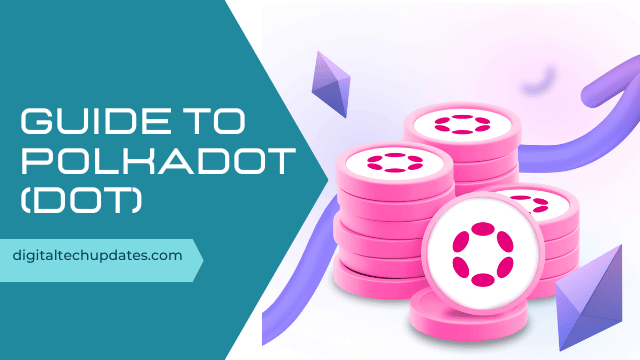Blockchain technology has revolutionized various industries by offering decentralized, transparent, and secure solutions. However, as the blockchain ecosystem grows, the need for seamless communication and interoperability between different chains becomes increasingly crucial. This article will delve into Polkadot (DOT), a groundbreaking project designed to tackle the challenge of interconnecting blockchains. In addition, if you are looking for a free and easy-to-use website that helps people find an education company to start learning about investments, you may visit https://quantum-xbeam.com.
The Genesis of Polkadot
Background of the Polkadot Project
Polkadot was conceived by Dr. Gavin Wood, one of Ethereum’s co-founders, and was officially launched in May 2020. The project aimed to address the limitations of existing blockchain networks, such as scalability and interoperability.
Founders and Development Team
Dr. Gavin Wood’s expertise in blockchain technology played a pivotal role in the inception of Polkadot. He assembled a talented team of developers and researchers to bring his vision to life, drawing from his prior experience working on Ethereum.
Polkadot’s Mission and Vision
Polkadot’s mission is to enable a decentralized web where multiple blockchains can communicate and share data, fostering a more interconnected and collaborative ecosystem. Its vision is to create a framework that allows different blockchains to work together seamlessly.
How Polkadot Works
Overview of Polkadot’s Architecture
At its core, Polkadot is designed around a unique architecture composed of a Relay Chain and multiple Parachains. The Relay Chain serves as the main chain, coordinating and securing the network, while Parachains are specialized chains that connect to the Relay Chain.
Parachains and the Relay Chain
Parachains are customizable blockchains that can serve various purposes, from smart contracts to identity verification. They connect to the Relay Chain to benefit from its security and scalability features.
Nominated Proof-of-Stake (NPoS) Consensus Mechanism
Polkadot employs a novel consensus mechanism called NPoS. In this system, DOT token holders nominate validators to secure the network. Validators are responsible for producing new blocks and confirming transactions, ensuring the network’s reliability.
Cross-Chain Message Passing (XCMP)
XCMP is Polkadot’s mechanism for enabling communication between different Parachains. It allows secure and efficient data transfer, making it possible for blockchains on the network to interact seamlessly.
Interoperability and Security Features
Polkadot prioritizes security and interoperability. Its design promotes the separation of concerns, ensuring that the Relay Chain remains secure while enabling Parachains to innovate independently.
The DOT Cryptocurrency
Role of DOT Tokens in the Polkadot Ecosystem
DOT tokens serve multiple functions within the Polkadot ecosystem. They are used for governance, staking, and bonding, allowing users to participate actively in the network’s decision-making and security.
Staking and Governance
Staking DOT tokens helps secure the network and entitles users to participate in on-chain governance. Polkadot’s governance system is designed to be transparent and inclusive, ensuring that the community’s voice is heard.
Utility and Use Cases of DOT
Besides governance and staking, DOT tokens are used for various purposes within the ecosystem, including payment for transaction fees, parachain slot auctions, and incentivizing validators.
Polkadot in Practice
Notable Projects and Parachains Built on Polkadot
Polkadot has attracted a wide array of projects and developers eager to build on its infrastructure. Examples include Acala, Moonbeam, and Chainlink, each offering unique features and use cases.
Advantages and Limitations of Using Polkadot
The advantages of Polkadot include scalability, security, and interoperability. However, it also faces challenges, such as the complexity of its governance system and competition from other blockchain interoperability solutions.
Case Studies of Successful Cross-Chain Interactions
Examining real-world use cases where Polkadot has facilitated cross-chain interactions highlights its practical utility and the potential for a more interconnected blockchain ecosystem.
Competitors and Collaborations
Comparison with Other Interoperability Solutions
Polkadot faces competition from other blockchain interoperability solutions, such as Cosmos and Ethereum 2.0. Comparing these platforms helps us understand the unique advantages of Polkadot.
Polkadot’s Collaborations and Partnerships in the Blockchain Space
Polkadot has formed strategic collaborations and partnerships with various blockchain projects, demonstrating its commitment to fostering a collaborative blockchain ecosystem.
Future Prospects and Challenges
Upcoming Developments and Roadmap
Polkadot has an ambitious roadmap, with plans for further enhancements and the introduction of features like parachain auctions, enabling more projects to join the network.
Potential Regulatory Challenges
As the blockchain industry evolves, regulatory challenges may arise. Polkadot and its community will need to navigate these challenges while ensuring compliance and continued growth.
Market Trends and Adoption Predictions
Analyzing market trends and adoption patterns can provide insights into Polkadot’s potential future role in the blockchain landscape.
Conclusion
In conclusion, Polkadot stands as a pioneering project in the blockchain space, addressing the crucial need for blockchain interoperability. With its innovative architecture, robust consensus mechanism, and active community, Polkadot has the potential to reshape the blockchain industry by creating a truly interconnected and collaborative ecosystem. As the technology continues to evolve, it will be fascinating to witness how Polkadot and its community navigate the challenges and opportunities that lie ahead.




